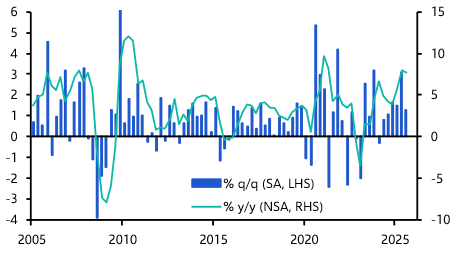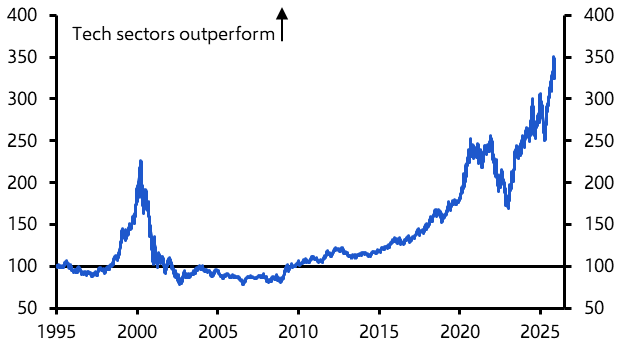Last week we held a series of conferences across Asia and Australia discussing the outlook for the global economy and financial markets. You can find recordings of all our presentations here. A recurring question from clients, perhaps unsurprisingly, centred on the outlook for China and the implications for economies elsewhere in the region.
China receives so much attention because of its size but also because uncertainties about the data make the economy something of a black box. A key message from our presentation was that there are two slowdowns going on in China: a cyclical one and a structural one.
It’s not difficult to find evidence of cyclical weakness in China. The manufacturing PMIs have dropped, the trade data have softened and auto sales are contracting at a double-digit annual rate. But, set against this, other sectors, most notably property construction, are holding up relatively well.
We track shifts in China’s economy using our China Activity Proxy (CAP), which we believe paints a more accurate picture of conditions on the ground than the official GDP data.
Fiscal and monetary policy is now being loosened, but the additional measures announced at last week’s National People’s Congress were relatively modest and the overall scale of stimulus so far has been much smaller than in previous downturns. (See Chart.) Economic conditions should stabilise by the second half of this year but, unlike after previous easing cycles, we don’t anticipate a significant rebound in growth to follow. All told, we expect China’s economy to expand by around 4.0-4.5% on our CAP measure over the next year or so, which is below the rates of around 5-6% we saw in 2017-18 and well below the 6-7% rates that were common as recently as five years ago.
Chart: Fiscal and Monetary Stimulus in China

This has important implications for the rest of the region. The past couple of decades have seen China establish itself as a manufacturing and trading hub, with spokes extending out to the rest of the Asia-Pacific region. Accordingly, if it sneezes, its neighbours will catch a cold.
The risks are arguably greatest in Australia, where weakness in China will come alongside a rapidly slowing housing market and against a backdrop of rising household debt. Australia’s economy has defied gravity for a long while but we suspect that 2019 will be the year it comes back to earth. The RBA kept interest rates on hold last week but soft Q4 GDP data released after the meeting support our long-held view that it will eventually have to loosen policy this year. One consequence is likely to be a weaker Aussie dollar over the next 12-18 months.
In addition to cyclical weakness, China is also facing a structural slowdown. Demographic pressures are building, but the much bigger issue is that an increasing misallocation of resource is pulling down productivity growth. As a result, we think Chinese growth could slow to as little as 2% a year within the space of a decade.
Structural weakness in China has implications for the economic outlook for the rest of the region over the next 10-20 years. The flaw in most long-term forecasts is that they tend to take the recent past and then project it forward in a straight line. This type of thinking appears to underpin the widespread view that the Asia-Pacific region will continue to record relatively rapid growth rates of 5% or so over the long-run. In contrast, we expect growth to slow to 3-4% over the next 20 years. This would still make Asia the fastest growing region of the world, and the centre of gravity of the global economy will continue to shift east. But the pace of that shift is likely to be slower than many expect.
In case you missed it:
- Our Chief Europe Economist, Andrew Kenningham, argues that there’s a growing possibility of more QE in the euro-zone.
- Our Markets Economist, Oliver Jones, considers the implications for financial markets of a US-China trade deal.
- Our latest Global Trade Monitor reveals that world trade contracted at its fastest pace since the global financial crisis in Q4 last year.




